 V-6
Miata Concept
V-6
Miata Concept
 V-6
Miata Concept
V-6
Miata Concept
Miata Forum member Richard Murray was fortunate enough to encounter the V-6 concept Miata along with one of the project engineers.
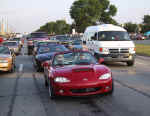 The
other day I was out riding my bicycle in traffic and came across a couple of
guys (actually they almost came across me) in the V6 Miata shown in a recent
issue of Road & Track. I finally convinced the driver, who was one of the
engineers on the project, to pull over so that I could look the car over, ask
a few questions, and snap pictures without being run over by a huge 4X4 that
wanted to share the lane space I was occupying.
The
other day I was out riding my bicycle in traffic and came across a couple of
guys (actually they almost came across me) in the V6 Miata shown in a recent
issue of Road & Track. I finally convinced the driver, who was one of the
engineers on the project, to pull over so that I could look the car over, ask
a few questions, and snap pictures without being run over by a huge 4X4 that
wanted to share the lane space I was occupying.
The gentleman was very forthcoming with facts and gossip that did not make it into the R&T article.
First some of the facts as related to me from my memory:
The car was completed only a couple of weeks before R&T showed up and the engineers did not have time to sort out the suspension to bring it back to normal handling. The modified car, with 3.0L Ford Duratec aluminum engine, weighs only 148lbs more than stock. The balance was only shifted 1%, from 51/49 to 52/48. The weight measurements were taken by 4 corner weighting with driver and 3/4 tank of gas, before and after. The hood is a good chunk of that weight - it felt like something I would use as a door to a bomb shelter. The car is an engineering demonstration, not a styling exercise.
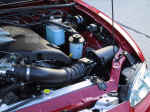 The
hood was only done so that they could use the stock LS intake and not have to
change the ECU calibration. With some thought, a special intake, and a custom/re-tuned
ECU you could go back to the stock hood and maybe use the current little bulge.
The
hood was only done so that they could use the stock LS intake and not have to
change the ECU calibration. With some thought, a special intake, and a custom/re-tuned
ECU you could go back to the stock hood and maybe use the current little bulge.
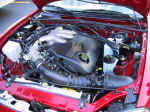 The
only major fabricated parts were (if I recall correctly) the exhaust, a one
inch adapter ring to mate the engine and transmission, a bracket to hold the
RX7 differential, and the suspension uprights. The suspension uprights were
fabricated to facilitate use of the RX7 brakes and half shafts with bearings
and they wanted the same wheels all around. With re-splined half shafts, I think
you could use the stock Miata bits. The RX7 Twin Turbo model transmission was
used instead of the Lincoln transmission since the Lincoln gearing was wrong
for the rear end and wheels. The RX7 transmission is also longer than the Lincoln
unit, which slides some weight rearward.
The
only major fabricated parts were (if I recall correctly) the exhaust, a one
inch adapter ring to mate the engine and transmission, a bracket to hold the
RX7 differential, and the suspension uprights. The suspension uprights were
fabricated to facilitate use of the RX7 brakes and half shafts with bearings
and they wanted the same wheels all around. With re-splined half shafts, I think
you could use the stock Miata bits. The RX7 Twin Turbo model transmission was
used instead of the Lincoln transmission since the Lincoln gearing was wrong
for the rear end and wheels. The RX7 transmission is also longer than the Lincoln
unit, which slides some weight rearward.
The body was not cut, and the stock stiffening braces were used. The sheet metal by the air conditioning and power steering pumps was rolled, though they did not have to as there was enough room. The engine could not be moved back even with cutting the body due to something protruding on the back of one of the heads. The air conditioning compressor was present, but not connected. The power steering pump was the stock LS unit, however it had been sent to California to be re-valved for the Miata steering rack. The air filter came from a Contour. SVT I think. Even the radiator was off the shelf, but not Ford's shelf. The radiator came from Flying Miata and fit in the stock location.
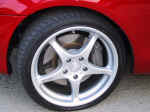 The
tires are 245/35/17 and fit at the stock ride height. The original stock springs,
A-arms, and shocks were used. Even with the RX7 parts and oversized wheels the
front suspension has the same un-sprung weight as stock, and the rear is only
1lb over stock.
The
tires are 245/35/17 and fit at the stock ride height. The original stock springs,
A-arms, and shocks were used. Even with the RX7 parts and oversized wheels the
front suspension has the same un-sprung weight as stock, and the rear is only
1lb over stock.
When I noticed that there was no room on the sides for turbochargers, the driver mentioned that if the intake was reworked, a supercharger might fit into the V between the cylinder banks. The engineer was thinking Eaton. I mentioned Lysholm, like the Mazda Millennia or MB AMG C-class. Are you listening, Corky?
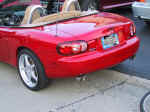 Now
the gossip, conjecture, and/or unsubstantiated opinion:
Now
the gossip, conjecture, and/or unsubstantiated opinion:
The engineer indicated that he and the other engineers were
very unhappy with the R&T article because R&T did not use most of the
information they provided and weighted the article space to the Japanese car.
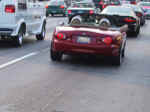 In
my opinion, R&T may have just editorially cut the article to fit the magazine.
I think R&T could have saved the travel money to Japan and just gone to
visit Bill Cardell to see an IRTB engine. The Japanese engine looks like a bored
out 1.8L with hotter cams and the same cooling system flow that the current
car has.
In
my opinion, R&T may have just editorially cut the article to fit the magazine.
I think R&T could have saved the travel money to Japan and just gone to
visit Bill Cardell to see an IRTB engine. The Japanese engine looks like a bored
out 1.8L with hotter cams and the same cooling system flow that the current
car has.
The V6 Miata could easily be produced as a low volume model. Perhaps Ford could re-badge it as a Lincoln, I think they need another image booster for that line. Or Mazda could follow the Porsche route and drop the power steering, A/C, power windows, etc. and sell it as a special sports model for the same price, or higher, as a fully loaded Miata special edition.
This is first Miata engine swap that I have seen that I would want to do.
If there are any Ford engineers who want to correct me on anything I have stated, contact me and I will provide a correction. I do not want to get anyone in trouble by identifying my source. Or just email me if you know what is going to happen to the car when Ford is done with it.
The Ford Advanced Powertrain Development V6 Miata came to Waterford Hills Race Course last Friday (08/24/01) as part of the continuing development of the car. I had an opportunity to discuss the car in more detail with the two development engineers who built the project and inspected the car during its brief driver rest stops. And, it was a whole lot safer this time than trying to dodge traffic on a bicycle.
I have been corrected that the front to rear balance I stated originally as 51/49 to 52/48 with a 3/4 tank and driver was really taken with only 1/4 tank and no driver. The balance of the original car was 50.5/49.5 with a full tank of gas, so it helps your balance to have a full tank (duh). The latest balance numbers, after some additional weight savings made in the last couple of weeks, are 50.9/49.1 also with a full tank.
The weight saving changes in the last few weeks included an aluminum driveshaft and some simplification of the cooling system and underhood area. The current car weights about 2650, including the test and calibration equipment.
The wheels on the car for R&T were 17X7.5 Borbets with 215/40 tires. They were replaced by 17X8 SSR Integrals with 225/35 front and 245/35 rear P7000's. The current combination is worth about 10lbs per corner, which with the aluminum uprights and aluminum RX-7 calipers, is how the un-sprung weight got back to stock.
The objective of this Advanced Powertrain Development project was to provide Ford/Mazda with a working prototype that could be put into production using as many parts from existing Ford/Mazda parts bins as possible.
The Ford 3.0L Duratec engine was chosen over the 2.5L K-Series Mazda because it is smaller, more powerful, and lighter. The Duratec engine is currently used in both FWD and RWD cars so issues of oil drainage and coolant routing were avoided. In its current configuration the engine uses a dual tract intake giving it two torque peaks.
In the hands of some people the stock transmission and differential has held up in turbo applications with more than the 200 to 220hp of the stock Duratec engine. However, it has also broken at these elevated horsepower and torque amounts, in the hands of others, and the Duratec engine does have plenty of torque. The RX-7 Twin Turbo (TT) transmission and differential were chosen, because in this application they are well within their strength. Options like the Borg-Warner T5 transmission and T-Bird rear end were rejected because they are not in the current production Mazda parts bin and the TT stuff is. After all the LHD RX-7 is still sold in Japan, and maybe in a few other LHD countries.
The only part that Mazda would have to get from outside is the engine, and considering the engines that Mazda sells to Ford, it might do a little to help the US balance of trade. And after all, it is still in the same family.
The car was on the track most of the day. The car went out with every group and must have put 100+ laps on it. I did not get an idea how many miles were put on the odometer. Waterford Hills is a short tight track with only two short straights. It is a major workout on suspension, brakes, and handling without giving an advantage to fast cars. Since this event was a drivers' training day, passing was allowed only on the straights after being waved by. Nobody was timing laps.
Only Ford engineers got to drive the car, however a couple of things were evident from watching. The V6 Miata could easily manage most of the track in third gear using the wide torque band of its dual tract intake. I am sure the car is capable of more, however it was being held in check since this was not a race, the car was on its first extended testing, and the drivers wanted to return the car whole. The car had no problem keeping up with any of the other cars. The car does not have much understeer on turn-in, but that is hard to tell without a steering wheel in your hands. The car does have plenty of power-on oversteer when dropped into second gear in a corner. The exhaust note sounds great from its dual exhaust. I understand it took four iterations to get the exhaust to sound right.
The car did suffer a couple of minor problems. A loose front A-arm cam bolt, that may have caused heavy steering when braking, and a dead starter. I understand the starter is only about 1/2in from an exhaust header and it may require a heat shield.
The only down side to having this engine in the Miata is that the other current uses of the 3.0L engine (Taurus, Lincoln LS, and Jaguar Type-S) do not have any after-market support. Of course, how many of the go fast parts of the Mazda 323GTX carried over to the Miata when it was first introduced. The owners (and markets) of those other cars might benefit from having a Miata lead the way. Now a tuner Lincoln LS with a manual transmission might attract someone younger than 70.
A real upside would be a car that starts at a higher level of performance than now. I can settle for 200+hp and wait until the after-market catches up. After all, I had my '91 for 6 years before I put a turbocharger into it and the improvements have not stopped since.
Richard Murray
richard.murray@eds.com
[Home] -
[FAQ] -
[Search] -
[Sponsors] -
[Forums]
[Garage] -
[Clubs] -
[Contact Us] -
[Disclosures] -
[More...]
Copyright
©1994-2024, Eunos Communications LLC
All rights reserved.